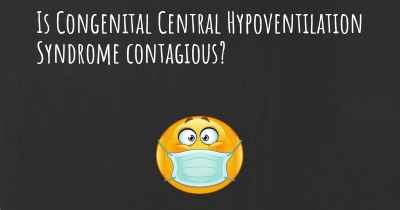How is Congenital Central Hypoventilation Syndrome diagnosed?
See how Congenital Central Hypoventilation Syndrome is diagnosed. Which specialists are essential to meet, what tests are needed and other useful information for the diagnosis of Congenital Central Hypoventilation Syndrome

Diagnosis of Congenital Central Hypoventilation Syndrome (CCHS)
Congenital Central Hypoventilation Syndrome (CCHS), also known as Ondine's Curse, is a rare genetic disorder that affects the control of breathing. It is typically diagnosed in infancy or early childhood. The diagnosis of CCHS involves a combination of clinical evaluation, genetic testing, and specialized respiratory function tests.
Clinical Evaluation
The initial step in diagnosing CCHS involves a thorough clinical evaluation by a healthcare professional. The doctor will review the patient's medical history, including any symptoms related to breathing difficulties, such as sleep apnea, hypoventilation, or cyanosis (bluish discoloration of the skin). They will also assess the patient's family history, as CCHS is an inherited disorder.
During the clinical evaluation, the doctor will perform a physical examination to look for any physical abnormalities that may be associated with CCHS. They will pay particular attention to the patient's respiratory system, including the lungs and chest wall. Additionally, they may evaluate the patient's neurological system, as CCHS can sometimes be associated with other neurological abnormalities.
Genetic Testing
Genetic testing plays a crucial role in diagnosing CCHS. The primary genetic cause of CCHS is a mutation in the PHOX2B gene, which is responsible for the development and function of the autonomic nervous system. Therefore, identifying mutations in the PHOX2B gene confirms the diagnosis of CCHS.
The genetic testing for CCHS involves a blood sample or a buccal swab to collect cells from the inside of the cheek. These samples are sent to a specialized laboratory where DNA sequencing is performed to analyze the PHOX2B gene. If a mutation is identified, it confirms the diagnosis of CCHS. However, it is important to note that in some cases, genetic testing may not detect a mutation, especially in individuals with atypical or milder forms of CCHS.
Respiratory Function Tests
Respiratory function tests are essential in evaluating the breathing patterns and abnormalities associated with CCHS. These tests help assess the patient's ventilatory response to changes in carbon dioxide (CO2) levels and oxygen (O2) saturation.
One of the primary tests used in diagnosing CCHS is the sleep study, also known as polysomnography. During a sleep study, the patient's breathing, heart rate, oxygen levels, and brain activity are monitored while they sleep. This test helps identify any abnormalities in breathing patterns, such as hypoventilation or apnea, which are characteristic of CCHS.
In addition to the sleep study, a test called the hypercapnic ventilatory response (HCVR) is performed. This test measures the patient's response to increased levels of carbon dioxide. Individuals with CCHS typically have a blunted or absent response to elevated CO2 levels, leading to inadequate ventilation.
Other Evaluations
In some cases, additional evaluations may be necessary to assess the extent of CCHS and its associated complications. These evaluations may include:
- Neurological evaluation: This may involve brain imaging studies, such as magnetic resonance imaging (MRI) or computed tomography (CT) scan, to assess the structure and function of the brain.
- Cardiac evaluation: As CCHS can sometimes be associated with cardiac abnormalities, an electrocardiogram (ECG) or echocardiogram may be performed to evaluate the heart's structure and function.
- Endocrine evaluation: CCHS can also affect the endocrine system, so hormone levels may be assessed to detect any abnormalities.
Conclusion
The diagnosis of Congenital Central Hypoventilation Syndrome (CCHS) involves a comprehensive approach, including clinical evaluation, genetic testing, and respiratory function tests. The clinical evaluation helps assess the patient's medical history, symptoms, and physical abnormalities. Genetic testing, primarily targeting the PHOX2B gene, confirms the diagnosis by identifying mutations. Respiratory function tests, such as sleep studies and hypercapnic ventilatory response tests, evaluate breathing patterns and abnormalities associated with CCHS. Additional evaluations, including neurological, cardiac, and endocrine assessments, may be performed to further understand the extent of CCHS and its associated complications.








